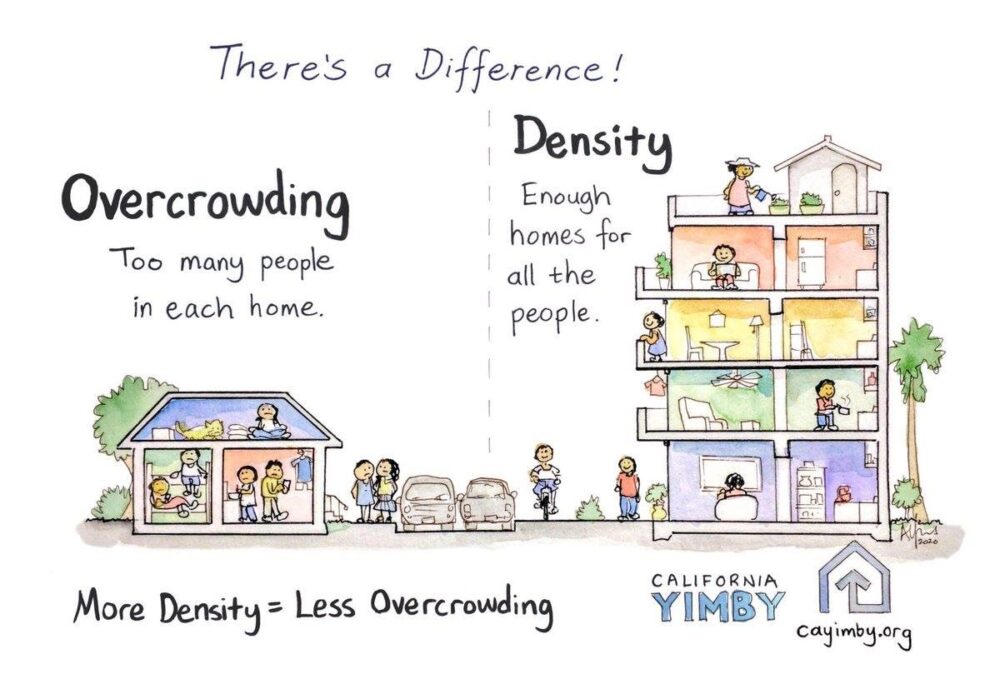How To Reduce Urban Overcrowding
How sprawling cities manage to be more overcrowded than the densest urban jungles
The Independent Institute has written a lot about homelessness, and will soon publish a report on market-oriented ways to fix the problem. It is not America’s only housing affordability-related issue, however. Obviously not every poor person is homeless, and you don’t have to be poor to suffer from urban overcrowding.
The next step up for many is to be underhoused. Many Americans live in units that are small, heavily populated, and excessively subdivided, in other words, overcrowded. In pricey coastal cities, large segments of the professional class live like this too, causing people to believe overcrowding is an inevitable fact of urban life. It is not.
First I’ll clarify what is meant by “overcrowding.” To the untrained eye, a dense city with tall buildings might automatically seem overcrowded. Urbanists define overcrowding as what happens inside the buildings. Jane Jacobs made this distinction in The Death & Life Of Great American Cities:
“Overcrowding means too many people in a dwelling for the number of rooms it contains. It has nothing to do with the number of dwellings on the land.”
The YIMBY movement has expanded on this sentiment, noting how density—especially within tall buildings—actually prevents overcrowding.
Tall buildings put more units on a given parcel than short buildings, meaning more people can have their own apartments rather than living in apartments together. Single-family homes, by contrast, are technically one unit but have multiple rooms. If one person lives in each room of a 4-bedroom home, that means 4 people share the kitchen, bathrooms and other common areas. Assuming these are 4 unrelated adults, I would define this as overcrowded, or at least unpleasant, as it deprives people of privacy and space. The Berkeley-based graphic design artist Alfred Twu drew this distinction between density and overcrowding in a meme for the organization California YIMBY:

Many U.S. cities, thanks to restrictive housing policies, provide the lifestyle drawn on the left side. They have large populations and high demand, but are under-zoned, with a predominately single-family housing stock.
Los Angeles is the perfect example of this mix, with the lowest per capita home permitting rate since 2004 of 20 major metros I studied. Thus it is the nation’s most overcrowded city (again, despite appearing from bird’s eye view to be sprawling and dispersed). According to HUD, it has the highest percentage of overcrowded homes (defined as more than 1 person per room) of any U.S. city. Its “severe overcrowding” rate (more than 1.5 people per room) is almost double second-place San Francisco.
I was able to learn, when visiting Los Angeles during a recent cross-country tour, what this does to people’s lives. I met people, young and old, working and professional class, who crammed in small rooms in small apartments filled with many other such rooms, all occupied. Sometimes even those rooms were divided by curtains, and the subdividing would extend to non-bedrooms, with people sleeping on living room couches or in closets. I even visited hostels filled not only with tourists, but local residents who worked full-time, but could afford nothing better than a bunk in rooms with a dozen other strangers.
I found the same in San Francisco. Steven Buss, a local YIMBY activist and Google software engineer, told me that despite making a low-6-figure salary, he and his coworkers share apartments with roommates, in his case inside The Mission District. He said that his friends who made less lived in further out parts of the metro, in even more substandard conditions.
“Through our bad housing policies we made it impossible for people to get by on anything short of a six-figure income job,” wrote Buss recently by Facebook chat.
There is a simple solution: build more housing. This means changing the types of housing developers can build. Urbanist Daniel Herriges wrote for Strong Towns about how America’s current housing stock is mismatched from the nation’s changing demographics. Over 80% of homes and apartments are built with two or more bedrooms, but single adults living alone account for 28% of households. Meanwhile the percentage of households featuring unrelated adults sharing a home is the same as the percentage of nuclear families. That is why so many singles must live together—with people they may not even know—in homes designed for large families.
Developers are restricted—through DUA laws, minimum unit size laws, and other zoning regulations—from building more studio and 1-bedroom apartments that would satisfy this growing singles demographic. Allowing developers to build this would let a greater number of people have their own apartment, meaning they wouldn’t need to live together. That would help reduce urban overcrowding.
Catalyst articles by Scott Beyer | Full Biography and Publications
